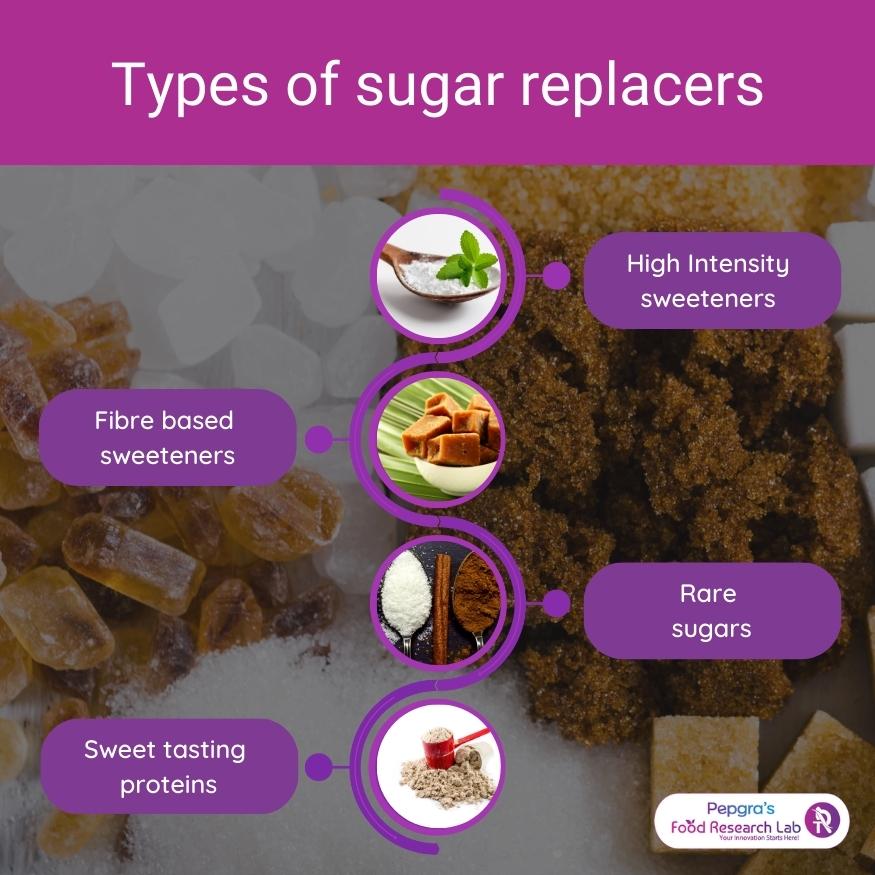
What is the latest innovation in sugar replacers?
Introduction
Several national and international organisations emphasise decreasing dietary sugar since it plays a role in the causation of non-communicable diseases and conditions like type-2 diabetes, obesity, and dental cavities/tooth decay. However, many assume that replacing sugar with ingredients like maltodextrin or saturated fats leads to poorer health outcomes. In addition, consumer awareness about the ill effects of sugar is also increasing, posing a challenge for the food industry. Sugar provides texture and bulk and acts as a preservative apart from the taste. The solution to the challenge can be answered by sugar replacers, which are increasingly gaining popularity among consumers and the food industries [1].
Types of sugar replacers

Figure 1: Types of sugar replacer
1.High-intensity sweeteners- They can be natural or artificial in origin. Artificial sweeteners like aspartame, sucralose, neotame, acesulfame-K and saccharin steviol glycosides are 200 to 13000 sweeter than sugar. They are primarily used in liquid and semi-liquid preparations but are expensive, and their consumption is highly regulated [1].
The latest innovation in sugar replacers is the development of new low-calorie sweeteners derived from natural sources, such as stevia and monk fruit. Stevioside extracted from Stevia leaves are 300 times sweeter than sugar. Compounds called Steviol glycosides are isolated from stevia leaves and are non-caloric, making them popular in the food industry [2].
Monk fruit was used as a traditional medicine in China for the common cold, cough, sore throat and chest congestion. The ripe fruit is sweeter than sugar by 300 times and can be used as a low-calorie option for diabetic and obese individuals. Monk fruit is considered as GRAS (Generally Recognised As Safe) by the U.S., and its consumption has skyrocketed, second only to stevia. In addition, it contains bioactive compounds like polyphenols, triterpenoids, flavonoids and essential oils that can protect against diseases and conditions like diabetes, cancer and obesity. [3, 4]
2. Fibre-based sweeteners– The objective of substituting sugar/sucrose with fibres in food is to decrease the calorie content. They can be soluble or insoluble in water. Soluble fibres like inulin and its derivatives like pectin and resistant dextrins can be used to formulate beverages to bring a mouthfeel. However, the type of product formulated will determine the kind of fibre [1].
3.Rare sugars– Rare sugars like allose, allulose, and tagatose are palatable and do not leave an aftertaste, unlike artificial sweeteners. They are naturally occurring and contain fewer calories than sugar. These substances either don’t get metabolised or are partially metabolised, making them a popular low-calorie sweetening agent [5].
4.Sweet tasting proteins-Research was done on the use of non-caloric sweeteners that are not derived from sugar, such as brazzein and thaumatin. Brazzein is found in a plant in the tropical forest in Cameroon, Congo and Gabon, while thaumatin is found in rainforest plants from Sierra Leone to Togo. These sweet-tasting plant-based proteins have the potential to be incorporated in various food products and may provide an alternative to traditional sugar replacers.
Conclusion
Sugar replacers have arisen from a need to substitute sugar since the latter is associated with adverse health outcomes like diabetes, obesity and tooth decay. Natural sources of sugar replacers are preferred by the food industry for product reformulation, for consumers’ demand for natural ingredients is increasing. High-intensity sweeteners, sweet-tasting proteins, rare sugars and fibre-based sweeteners are explored. However, it is worth noting that the field of sugar replacers is constantly evolving, and there may be innovations.
How the Food Research Lab can help
The Food Research Lab offers ingredient development services for its clients. It ensures that the ingredients are of the highest quality, ethically sourced and free from hazards. The facility also conducts cost analysis so that the ingredients are reasonably priced.





